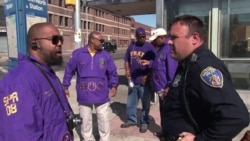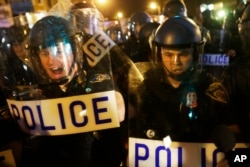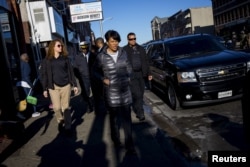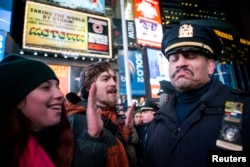Police involvement in the recent deaths of African-American men in several U.S. cities has sparked not only protests but also broader conversations about how to address racial inequities and to improve the relationship between officers and the people they’re sworn to protect and serve.
In Baltimore, where last month’s death of 25-year-old Freddie Gray triggered sometimes-violent protests and last week prompted the U.S. Justice Department to announce an investigation into possible civil rights violations, officers maintain they're trying to reduce crime in a neighborhood with the highest numbers of homicides and shootings.
But residents there — and in cities such as New York, Ferguson, Missouri, and Cleveland, Ohio — accuse them of using aggressive tactics and brutality.
"The police officers cannot keep on doing what they are doing to the black community," said Darryl Phifer, a Baltimore resident. "It is not really a black or white thing, but most of the brothers are feeling a certain kind of way."
Black men believe they’re targeted, Phifer said, and data offer support for that belief. The per capita arrest rate of Baltimore’s black residents is at least triple that of other races, with African-Americans sometimes arrested for offenses, such as marijuana possession, that whites are not, according to The Baltimore Sun.
Nationally, African-Americans are arrested at much higher rates than people of other races, USA Today discovered in an analysis of FBI data last year. It found that while blacks in Ferguson were almost three times as likely to be arrested as people of other races, that rate was surpassed in nearly 1,600 other U.S. communities. The news organization cautioned that the disparities didn't necessarily reflect biased policing, but warranted further study.
Improvements needed
It will take time to improve Baltimore’s community-police relations, said Antonio Hayes, a Maryland state lawmaker.
"There is a lot of distrust on both ends of the spectrum, whether you are a citizen of Baltimore or a police officer,” the Democratic legislator said. “So it's going to take intentional and strong efforts on both of those parts to come together."
Hayes represents District 40, which includes the West Baltimore neighborhood of Sandtown-Winchester where Gray grew up. He suffered a fatal injury April 12 while in police custody and died a week later.
His death touched off demonstrations against perceived excessive force by police and, on the night of his funeral, rioting in parts of the city. Maryland’s governor called in the National Guard to quell unrest.
Six police officers, including three African-Americans, face criminal charges in Gray’s death.
Baltimore Mayor Stephanie Rawlings-Blake asked the Justice Department to conduct a civil rights investigation, and last week it announced it would probe whether there’s a pattern of abuse or discrimination in the police department. It also will look at officers’ individual histories and whether those include discrimination or use of excessive force.
The federal review could take months, The Baltimore Sun reported, noting the Justice Department’s civil rights division has investigated 20 police departments over the last six years. In March, it cleared a white officer of civil rights violations in last August’s death of a black teenager in Ferguson, but it found the department routinely violated the rights of blacks.
"We have to believe in a police department that believes wholeheartedly in community policing … to have safer communities," Baltimore’s mayor said. "And, in order to do that, we have to find a way toward that foundation of trust. This relationship cannot go anywhere without that trust."
Rebuilding relations
Meanwhile, she and others in Baltimore are searching for ways to rebuild relations with police.
"Nowadays, police don't know you and you do not know the police," said JoAnn Brewer, who lives in West Baltimore.
Brewer has been pressing police for years to find the killers of her son and grandson, who died in separate incidents. She wants police to interact with residents as they did years ago.
"When we had police officers walking the beat, you knew them by name,” Brewer said of the patrols. The officers “knew the families on the street. If something was wrong, you could tell them and they would take care of it. That is where they went wrong, when they took the police off the beat."
Front-line facilitators
Former Baltimore police officer Rob Weinhold agrees.
"Police officers can be great facilitators, conveners and problem solvers — as long as they have the resources to bring to bear in communities," said Weinhold, now a crisis management expert for the Fallston Group.
" … They are often the first point of contact” and can play a role in improving the quality of life," he said. "I think a sound community policing model is the way to go, and I think it creates long-term, sustainable change."
Weinhold, who patrolled city streets for some of his 13 years with the force, agreed police need to get out of their vehicles to establish trusting relationships with residents. "But many times, police officers get so caught up in having to go from call to call to call, they don’t have the discretionary time to stop and talk," he explained.
He cited another impediment to good policing: "Government by and large can be very disjointed, where agencies don’t talk with one another except at the cabinet level."
Weinhold urged aligning ground-level police with city employees working in health, housing, public works and other departments "so people in government all know one another and know how to deploy the right resources to the neighborhood," he said. "A critical issue may be crime, but it also may be grime."
Baltimore’s police commissioner, Anthony W. Batts, in a March profile in The Sun, said after his 2012 arrival he’d sought to improve the city’s racial climate. He ordered patrol officers to spend at least part of their shifts on foot. He also encouraged volunteering for a children’s reading program, among other measures to connect with residents.
Lesson from Los Angeles
Community policing is one of the six "pillars" recommended in the President’s Task Force on 21st Century Policing’s interim report. Issued in March, the report endorses "a focus on intervention and prevention through problem solving" combined with “collaborative partnerships with schools, social services and other stakeholders” to strengthen public safety and trust.
An analyst says more community-based policing and economic development aided Los Angeles after rioting there decades ago. Aggressive police tactics against black men triggered the Watts riots in 1965 and, in 1992, after the beating of Rodney King and the acquittal of officers accused of attacking him.
The city responded to the 1992 unrest by promoting economic development and community outreach, said political analyst Dan Schnur of the University of Southern California.
"Community leaders and police leadership stepped up and said, 'This is untenable.' And both groups made a much greater effort and a more sustained effort over the last couple of decades," Schnur said.
For example, the Watts Gang Task Force brings together local leaders and police for weekly meetings, and special police units patrol public housing projects daily as part of a community safety partnership. The Los Angeles Police Department’s broader outreach has included activities such as mentoring kids and coaching youth football teams.
"It gave our officers, who really only responded to bad situations where we get called and they see the worst part of people at their worst moment, [a chance] to see a different side of the community," Captain Phillip Tingirides told VOA for a story earlier this year.
Shooting raises concern
However, tension persists. Some minority neighborhoods are still plagued with high rates of unemployment, crime and violence. And the fatal May 5 shooting of a homeless black man in Los Angeles’ Venice neighborhood prompted a vigil and community forum two days later.
"Many people are angry … at a use of force that they decry as unjustified and inappropriate," City Councilman Mike Bonin said at the forum.
But so far, protests over the death of Brendon “Dizzle” Glenn have been peaceful, and authorities continue to investigate the shooting.
California is the nation’s most populous and diverse state, census data show. A recent survey by the University of Southern California and Los Angeles Times showed that most Californians see race relations as "good" or "excellent" in their own neighborhoods — and better than in other parts of the country.
Building community
"Proximity leads to familiarity, and if you live in a community where people aren't like you, whether on the basis of race or ethnicity or religious affiliation or sexual orientation, you're much more likely to be able to build some commonality, some levels of understanding," said Schnur, who directed the survey.
Still, slightly more than half of the respondents described California’s race relations as "just fair" or "poor." And respondents in various ethnic and racial groups indicated they believe police treat African-Americans more harshly.
Confidence in police officers varies substantially by race or ethnicity, according to a national 2014 Pew Research poll cited by the policing task force report. Asked whether police do a good job of enforcing the law in their respective communities, 83 percent of non-Hispanic whites indicated yes, and only 63 percent of Hispanics and 52 percent of blacks agreed.
New Yorkers doubt fairness
In New York, the racial thermometer rose following last July's death of Eric Garner, a 43-year-old black man who was put in a police chokehold during his arrest for selling loose cigarettes. He repeatedly gasped for air, crying, “I can’t breathe."
Thousands marched the next month in peaceful protest over Garner’s death and hit the streets again in December when a grand jury refused to indict the police.
Most New Yorkers believe the criminal justice system treats people unfairly, a Siena College poll found in January.
"If the people didn’t riot and they didn’t protest, those cops would have never been charged," one unidentified woman observed.
Anti-police sentiment is being fueled by "agitators" such as the Reverend Al Sharpton, retired New York City Police Captain Joe Concannon said at a news briefing earlier this week.
Sharpton, head of the civil rights organization National Action Network, has accused prosecutors who failed to bring charges against police — in the Garner case and others — of "playing politics…. They put the evidence aside, take four or five months to study it and come back with nothing."
Concannon said such rhetoric undermines police, especially in neighborhoods that need their service the most.
He has called for a national boycott of Baltimore, saying “the failure in leadership … has exposed the city’s police and the community to great danger” by charging the six officers involved in Gray’s arrest.
He also encouraged candlelight memorials to fallen officers during the current National Police Week, which ends Saturday.
VOA contributors to this report included Bernard Shusman from New York, Mike O’Sullivan from Los Angeles and Jeff Swicord from Washington.














